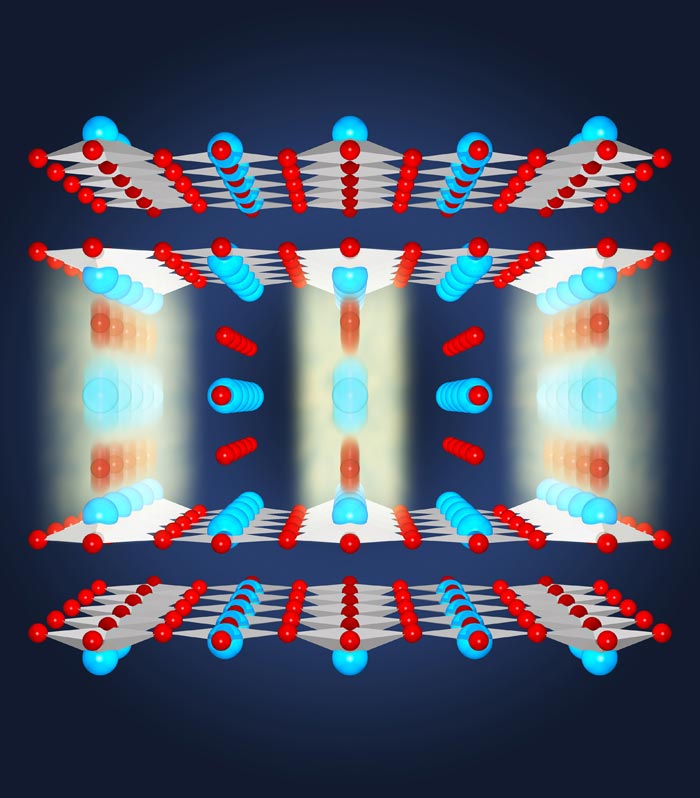
Rattled Atoms Reveal Secrets of High-Temperature Superconductivity

Jörg Harms/Max Planck Institute for the Structure and Dynamics of Matter
In a high-temperature superconducting material known as YBCO, light from a laser causes oxygen atoms (red) to vibrate between layers of copper oxide that are just two molecules thick. (The copper atoms are shown in blue.) This jars atoms in those layers out of their normal positions in a way that likely favors superconductivity. In this short-lived state, the distance between copper oxide planes within a layer increases, while the distance between the layers decreases.
An experiment at the Department of Energy’s SLAC National Accelerator Laboratory provided the first fleeting glimpse of the atomic structure of a material as it entered a state resembling room-temperature superconductivity – a long-sought phenomenon in which materials might conduct electricity with 100 percent efficiency under everyday conditions.
Researchers used a specific wavelength of laser light to rattle the atomic structure of a material called yttrium barium copper oxide, or YBCO. Then they probed the resulting changes in the structure with an X-ray laser beam from the Linac Coherent Light Source (LCLS), a DOE Office of Science User Facility.
They discovered that the initial exposure to laser light triggered specific shifts in copper and oxygen atoms that squeezed and stretched the distances between them, creating a temporary alignment that exhibited signs of superconductivity for a few trillionths of a second at well above room temperature – up to 60 degrees Celsius (140 degrees Fahrenheit). The scientists coupled data from the experiment with theory to show how these changes in atomic positions allow a transfer of electrons that drives the superconductivity.
New Views of Atoms in Motion
“This is a highly interesting state, even though it only exists for a short period of time,” said Roman Mankowsky of the Max Planck Institute for the Structure and Dynamics of Matter in Hamburg, Germany, who was lead author of a report on the experiment in the Dec. 4 print issue of Nature. “When the laser excites the material, it shifts the atoms and changes the structure. We hope these results will ultimately help in the design of new materials to enhance superconductivity.”
Sustaining such a state at room temperature would revolutionize many fields, making the electrical grid more efficient and enabling more powerful and compact computers. Traditional superconductors operate only at temperatures close to absolute zero. YBCO is one of a handful of materials discovered since 1986 that superconduct at somewhat higher temperatures; but they still have to be chilled to at least minus 135 degrees Celsius in order to sustain superconductivity, and scientists still don’t know what allows these so-called high-temperature superconductors to carry electricity with zero resistance.
A Powerful Tool for Exploring Superconductivity
Josh Turner, a SLAC staff scientist who has led other studies of YBCO at the LCLS, said powerful tools such as X-ray lasers have excited new interest in superconductor research by allowing researchers to isolate a specific property that they want to learn more about. This is important because high-temperature superconductors can exhibit a tangle of magnetic, electronic and structural properties that may compete or cooperate as the material moves toward a superconducting state. For example, another recently published LCLS study found that exciting YBCO with the same optical laser light disrupts an electronic order that competes with superconductivity.
“What LCLS is now showing us is how these different properties change over short times,” Turner said. “We can actually see how the electrons or atoms are moving.”
Mankowsky said future experiments at LCLS could try to sustain the superconducting state for longer periods, use a combination of experimental techniques to study how other properties evolve in the transition into the superconducting state and explore whether the same structural changes are at work in other high-temperature superconductors.
Researchers from the National Center for Scientific Research in France, Paul Scherrer Institute in Switzerland, Max Planck Institute for Solid State Research in Germany, Swiss Federal Institute of Technology, College of France, University of Geneva, Oxford University in the United Kingdom, the Center for Free-Electron Laser Science in Germany, and University of Hamburg in Germany also participated in the study. The work was supported by the European Research Council, German Science Foundation, Swiss National Superconducting Center and Swiss National Science Foundation.
SLAC is a multi-program laboratory exploring frontier questions in photon science, astrophysics, particle physics and accelerator research. Located in Menlo Park, Calif., SLAC is operated by Stanford University for the U.S. Department of Energy's Office of Science. For more information, please visit slac.stanford.edu.
SLAC National Accelerator Laboratory is supported by the Office of Science of the U.S. Department of Energy. The Office of Science is the single largest supporter of basic research in the physical sciences in the United States, and is working to address some of the most pressing challenges of our time. For more information, please visit science.energy.gov.














